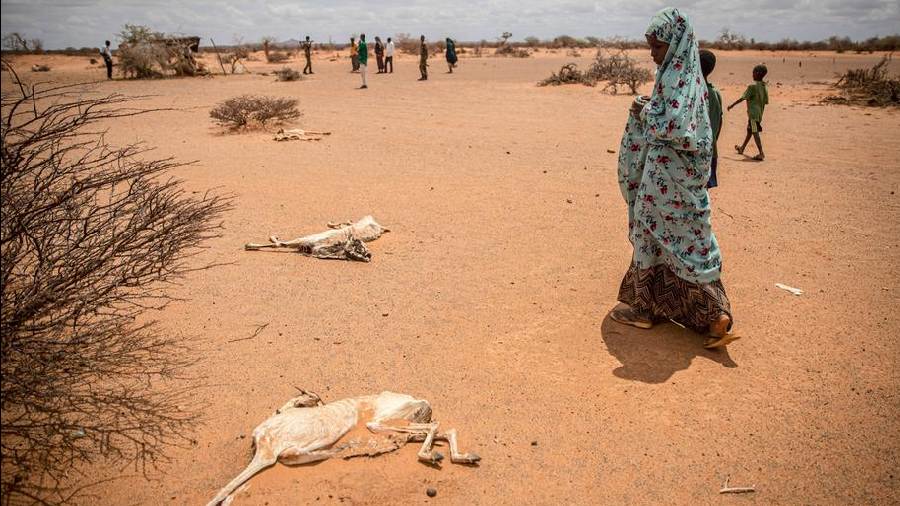The International Rescue Committee was founded in 1933, at the suggestion of Jewish refugee Albert Einstein, to rescue people from the Nazi regime. Today, the IRC helps victims of war around the world.
For the last 10 years, the organization has published its Emergency Watchlist: the 20 countries at greatest risk of deteriorating into a humanitarian crisis.
Factors such as economic resilience, the intensity of conflicts, natural disasters and the displacement of people are all taken into account.
The countries in the top 10 (in this order) are: Somalia, Ethiopia, Afghanistan, the Democratic Republic of Congo, Yemen, Syria, South Sudan, Burkina Faso, Haiti and Ukraine.
Numbers 11 to 20 are: the Central African Republic, Chad, Lebanon, Mali, Myanmar, Niger, Nigeria, Pakistan, Sudan and Venezuela.
Funding-gaps for international aid
However, the IRC emphasizes that the selection of countries is not related to the severity of existing crises but rather the "risk of deterioration” those countries face.
The Watchlist highlights where intervention is needed in the hope of averting humanitarian catastrophes.
"The most important message of this year's Emergency Watchlist is that crises are getting worse, crises are accelerating, but there are things we can do about it," the IRC's George Readings told DW.
The Emergency Watchlist for 2023 shows that record levels of humanitarian aid are required and foresees major threats in the year ahead.
The longer-term trend is also worrying: according to the IRC, 81 million people worldwide needed humanitarian assistance in 2014; today that number is 339 million. Around 90% of them live in countries on the Emergency Watchlist.
At the same time, the funding gap for international aid is widening: needs are growing, but less and less funding is being allocated.
In 2022, according to the IRC, there was a $27 billion (€25.3 billion) shortfall compared to $24 billion just over a decade earlier.
The report also points to growing inequality: "When looking at Watchlist countries, it is clear that armed conflict, the climate crisis, and economic turmoil are pushing a growing minority of the world's population into ever deeper crisis at the same time that, elsewhere, economic development has been lifting record numbers of people out of poverty."
Accelerators of crisis
The organization identifies armed conflict, climate change and economic turmoil as the top three accelerators of crisis.
In almost all the countries listed, crises have existed for a long time, but these factors exacerbate them — or trigger new crises.
According to the report, violent conflicts account for 80% of humanitarian needs. In many cases, civilians are the ones who are suffering most.
Without exception, all of the 20 Watchlist countries are affected by armed conflict.
Climate change is exacerbating humanitarian emergencies in many of the most vulnerable countries and economic turmoil is exacerbating poverty.
Drought and conflict in Somalia
Three countries on three different continents are highlighted in the report:
Somalia is at the top of the list due to a catastrophic food crisis that arose from a combination of years of drought and decades of conflict.
Added to this is Somalia's dependence on a new crisis region, says George Readings.
"Before the war in Ukraine, Somalia was importing 90% of its grain from Russia and Ukraine. Now that's been massively disrupted, food prices have increased on global markets since the war in Ukraine [began]."
All of these factors combined make Somalia the most severely affected country in the world on the Emergency Watchlist.
Last year, Afghanistan was in first place on the list. Now it is in third place, not because the situation there has improved, but because it has worsened in East Africa.
In Afghanistan, the population has been hit by economic collapse since the Taliban took power, and the West withdrew.
Virtually the entire population lives in poverty, and a long, hard winter has only just begun.
Ukraine is only on the list because of the invasion by Russia — a war that has caused the largest refugee crisis in decades, according to UNHCR.
Russian attacks on civilian infrastructure have cut millions of people off from electricity and water supplies. It is only because of rapid and substantial aid from abroad that Ukraine is not worse off.
Against defeatism
This year, the IRC is taking a special look at what it calls guardrails. By this, it means civic institutions and assistance at the local, national or international level that prevent people in crisis from falling off the cliff completely.
It is precisely these "guardrails," however, that the IRC says are being weakened in many countries. But this weakening of the guardrails writes IRC President David Miliband in the foreword to the report, "is a choice, not an inevitability, and as such needs to be addressed."
"With a concerted effort at multiple levels we can start to rebuild those guardrails," George Readings told DW. "And if we can do that we can start to bring down the level of humanitarian need and the level of crises in the world."
The IRC cites a number of positive examples too: the UN-brokered ceasefire in Yemen, "the longest period of relative peace (...) since the war began in 2014"; the construction of coastal defenses in Bangladesh, "which has saved thousands of lives (...)"; and finally, the UN-brokered grain agreement from August this year in Ukraine, which allowed grain exports to resume, especially to the most dependent countries in Africa.
The crises, the report admits, did not end there. But at least the impacts of those crises could be mitigated.
And they show that "we must not allow defeatism to win."










